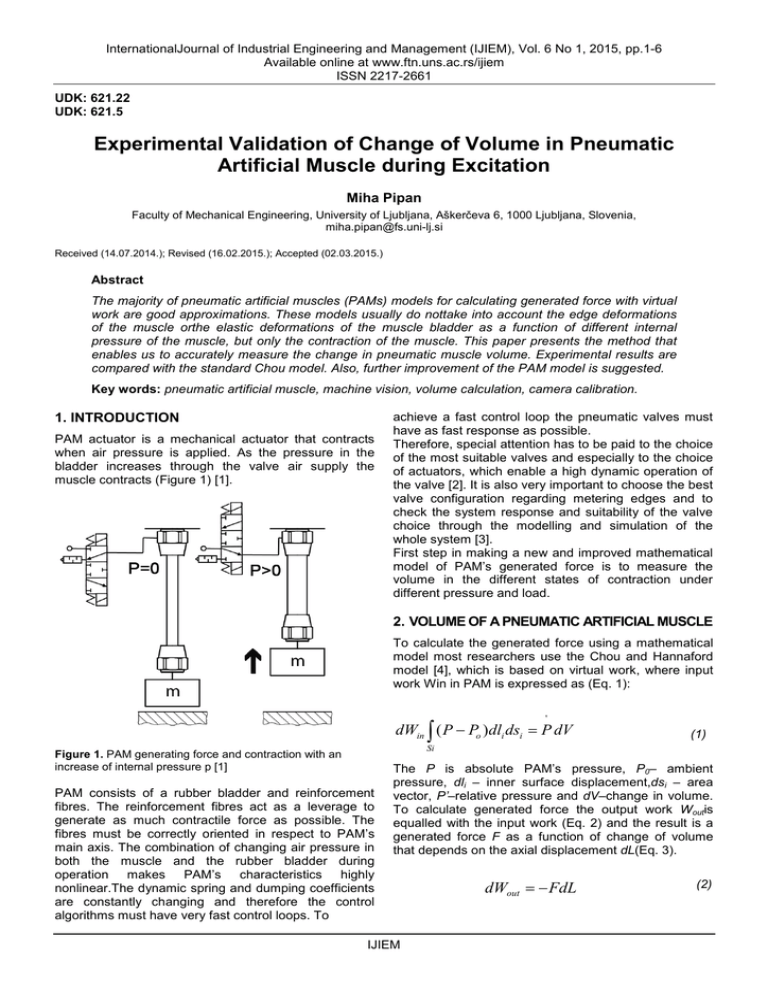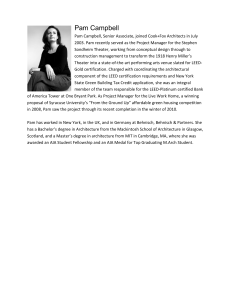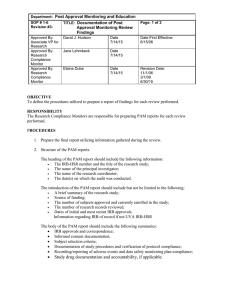
InternationalJournal of Industrial Engineering and Management (IJIEM), Vol. 6 No 1, 2015, pp.1-6
Available online at www.ftn.uns.ac.rs/ijiem
ISSN 2217-2661
UDK: 621.22
UDK: 621.5
Experimental Validation of Change of Volume in Pneumatic
Artificial Muscle during Excitation
Miha Pipan
Faculty of Mechanical Engineering, University of Ljubljana, Aškerčeva 6, 1000 Ljubljana, Slovenia,
miha.pipan@fs.uni-lj.si
Received (14.07.2014.); Revised (16.02.2015.); Accepted (02.03.2015.)
Abstract
The majority of pneumatic artificial muscles (PAMs) models for calculating generated force with virtual
work are good approximations. These models usually do nottake into account the edge deformations
of the muscle orthe elastic deformations of the muscle bladder as a function of different internal
pressure of the muscle, but only the contraction of the muscle. This paper presents the method that
enables us to accurately measure the change in pneumatic muscle volume. Experimental results are
compared with the standard Chou model. Also, further improvement of the PAM model is suggested.
Key words: pneumatic artificial muscle, machine vision, volume calculation, camera calibration.
1. INTRODUCTION
PAM actuator is a mechanical actuator that contracts
when air pressure is applied. As the pressure in the
bladder increases through the valve air supply the
muscle contracts (Figure 1) [1].
achieve a fast control loop the pneumatic valves must
have as fast response as possible.
Therefore, special attention has to be paid to the choice
of the most suitable valves and especially to the choice
of actuators, which enable a high dynamic operation of
the valve [2]. It is also very important to choose the best
valve configuration regarding metering edges and to
check the system response and suitability of the valve
choice through the modelling and simulation of the
whole system [3].
First step in making a new and improved mathematical
model of PAM’s generated force is to measure the
volume in the different states of contraction under
different pressure and load.
2. VOLUME OF A PNEUMATIC ARTIFICIAL MUSCLE
To calculate the generated force using a mathematical
model most researchers use the Chou and Hannaford
model [4], which is based on virtual work, where input
work Win in PAM is expressed as (Eq. 1):
'
dWin ∫ ( P − Po )dli dsi = P dV
(1)
Si
Figure 1. PAM generating force and contraction with an
increase of internal pressure p [1]
PAM consists of a rubber bladder and reinforcement
fibres. The reinforcement fibres act as a leverage to
generate as much contractile force as possible. The
fibres must be correctly oriented in respect to PAM’s
main axis. The combination of changing air pressure in
both the muscle and the rubber bladder during
operation makes PAM’s characteristics highly
nonlinear.The dynamic spring and dumping coefficients
are constantly changing and therefore the control
algorithms must have very fast control loops. To
The P is absolute PAM’s pressure, P0– ambient
pressure, dli – inner surface displacement,dsi – area
vector, P’–relative pressure and dV–change in volume.
To calculate generated force the output work Woutis
equalled with the input work (Eq. 2) and the result is a
generated force F as a function of change of volume
that depends on the axial displacement dL(Eq. 3).
IJIEM
dWout = − FdL
(2)
2
Pipan
F = −p
dV
dL
(3)
deformation. Figure 3 presents the experimental setup
during the camera calibration using the algorithm, which
is described in detail in [8].
The Chou model then suggests, that the fibre length
does not change and the generated force is calculated
as a function of change in fibre angle (Eq. 4)
'
F=
πD02 P
4
(3 cos 2 − 1)
(4)
This widely used model does not take into account that
fibres can extendand therefore the volume changes.
Tsagarakiset. al.[5] and Tondu et.al. [6]have made
some attempts to improve this model byincluding
friction loss in bladder. . In this paper we show an
experiment that enabled us to measure the internal
volume in the muscle and to compare it to the
mathematical model.
2. EXPERIMENTAL SETUP
To measure the volume of the muscle the machine
vision was applied (Figure 2). The machine vision
applications are widely used in industry for fault
detection, measurement and data extraction [7]. The
pneumatic muscle was fixed horizontally on linear
guides with clamping mechanism. The contraction of
the muscle was fixed in different positions while the
internal pressure was increased from 1 to 6 bar. During
the incremental pressure raise the pictures of PAM
were taken for further analysis. The pressure inside the
muscle was controlled by two fast switching valves, the
pressure sensor and an embedded PCX controller
(Figure 2).
Figure 3. Camera calibration using chess board. A – CCD
camera, B – PC, C – chess board and D – PCX controller
After calibratingthe camera the relative width of the
camera pixels has to be calculated. This can be done
with the use of the calibration blocks.
3. THE EXPERIMENT
For the experiment we chose the combination of
pressures from 1 to 6 bar and contractions from 0 mm
to maximum PAM’s contraction. The combinations of
the measured parameters are shown in table 1.
The contraction was made in 2.5 mm steps from 0 to
maximum contraction. Maximum contraction depends
on the pressure in the muscle and increases to
maximum of 25% of total PAM’s length at 6 bar.
Table 1. Combinations of the measured parameters
Pressure [bar]
1
2
Figure 2. Experimental setup for the image acquisition of
PAM’s volume. A – PC with Matlab, B – linear guides with
clamping device, C – pressure sensor, D – displacement
sensor, F – force sensor, G - fast switching valves, H – high
resolution industrial camera and I – PCX controller
Cont.
[mm]
To achieve best possible accuracy the camera had to
be calibrated. The calibration was used for correction of
radial and axial distortion, due to camera lens
IJIEM
0 -5
0 -23
3
035
4
5
6
0 - 40
0- 45
0 -50
Pipan
3
4. CALCULATION OF PAM’S VOLUME
After the acquisition of all states of PAM, the images
had to be prepared for analysis. This was done in 3
steps:
A) Defining a region of interest and cropping the
picture;
B) Converting the cropped picture from RGB to
binary form and reducing noise and mask
PAM’s logo;
C) Inverting picture for blob analysis.
All three steps are shown in figure 4.
Figure 5. Calculation of volume using Guldin’s rule.AS – area
under the curve, y0 – distance from rotational axis to the
centre of gravity of the area, y – function of the curve and S –
length of the curve
The volume is therefore calculated as shown in
equation (5).
V=2 πy 0 As
(5)
We used the blob analysisto calculate the y0 and AS.
The blob analysis was done in the following steps:
A) Loading binary image to memory;
B) Findingblob;
C) Determining the centre, minor axis, major axis
and angle of the blob;
D) Rotating the blob and making two identical
parts;
E) Makingblob analysis of upper and lower parts,
calculating their area and distance to rotation
axis;
F) Calculating the average value of upper and
lower area and centre of gravity.
Figure 6 shows two detected blobs with calculated area
and centre of gravity.
Figure 4. Image preparation for analysis
After the image preparation, the volume of the
pneumatic muscle was determined with the use of
blob analysis in Matlab [9] and the use of Guldin’s rule
[10] for calculation of volume for rotated area.
Guldin’s rule states that the volume of the solid, which
can be created by rotating a 2D shape around an
external axis, is equal to the product of the area of the
rotated shape and the distance travelled by the
shape's geometric centroid, as shown on figure 5.
Figure 6. Calculated area and centre of gravity for upper and
lower part of PAM for calculation of y0 and AS
However, the calculated volume presented the entire
volume of the muscle and not only the inside volume of
the air. Therefore, in this paper we must subtract the
calculated volume with the volume of the bladder.
The bladder is made from rubber and is known to be
incompressible [11], therefore, we must calculate the
volume and make it constant. The volume is calculated
IJIEM
4
Pipan
by taking one PAM apart and by measuring the inner
and outer diameter.
Table 2. Measurement results for PAM
Length
[mm]
200
Inner
diameter
[mm]
20
Bladder
thickness
[mm]
2,05
Volume Vp
3
[mm ]
The results of the measurement are presented in table
2.
After calculatingthebladder volume, we were able to
calculate the volume of PAM in different states and
compare it to the standard Chou model.
5. EXPERIMENTAL RESULTS AND COMPARISON
TO CHOU MODEL
28401
Figure 7. shows a cut out part of PAM used for
measurement of dimensions and determination of the
angle of fibres in the bladder.
The experimentally acquired data clearly show that the
internal volume of the muscle increases with the
increase of pressure while the level of contraction stays
constant. This is not included in Chou’s model. In figure
10 the graph of measured volume of PAM is shown at
different contractions and pressures.
Figure 7. Cut out part of PAM for measurement of bladder
dimensions (A) and fibre angle α (B).
The PAM fibres are positioned in the bladder in two
layers one over another as shown in figure 8.
Figure 10. Change of PAM’s internal volume as a function of
contraction and pressure
Closer look of the data (see Figure 11) shows that at
the same contractions of the PAM and at different
pressures the volume changes nonlinearly. Figure 11
displays only the acquired data of PAM’s volume at
contractions between 15 and 17.5 mm.
Figure 8. Two layers of PAM fibres(A – PAM bladder, B – first
layer of fibres, C – second layer of fibres)
The angles of fibres of the upper and lower layers are
opposite to each other to prevent the PAM from twisting
under contraction so that only axial force is generated.
The angle of reinforcement fibres angle α is 25° and is
shown in image 9.
Figure 11. Detail A - Change of volume for contraction
between 15 and 17.5 mm
Image 9. Angle α of the upper reinforcement fibre layer.
We can conclude from the observations that the
difference in volume at all contractions is always only a
function of the pressure. Figure 12 contains a graph
representing the relation between the calculated
IJIEM
Pipan
5
volume, difference of the muscle and the incremental
pressure change from 1 to 6 bar.
Figure 12. Change of volume in % depending on muscle
pressure
A comparison between the experimental data and the
Chou model (see Figure 13) shows that in general the
Chou model corresponds with the experimental results
of the volume change only at the PAM pressure of P =
1 bar. But at the PAM pressure of P = 1 bar the muscle
can contract only approximately 3 %. Therefore, at the
PAM pressure of P = 6 bar, when the muscle
contraction can reach full 25% of PAM’s length, the
difference in the volume comparingthe measured data
and the Chou model is the greatest.
Figure 13. The comparison of the Chou model and the
gathered experimental data.
The Chou model can therefore be improved by a simple
function, which takes into account the stretching of the
bladder under different pressures and then uses this
new model to calculate generated force.
The difference between experimental data for the
muscle volume at the pressure of p = 6 bar and the
3
Chou model is shown in mm in figure 14.
It is obvious that the deviation between the Chou model
and the experimental results is nonlinear and depends
on the PAM’s contraction.
Figure 14. Calculated difference between the Chou model
and the experimental data for PAM at 6 bar and contraction
from 0 to 50 mm
6. DISCUSSION AND CONCLUSION
The aim of the experimental research, presented in this
paper was to measure the change of the PAM’s volume
at different contractions and pressures and to compare
the results with the Chou model. The standard and the
most used Chou model assumes that fibres in PAM
bladder do notextend under pressure and therefore the
volume does notchange. In this paper we proved that
there is a significant change in the volume of the PAM
in comparison to the Chou model.
The volume was measured with the use of high
resolution machine vision camera for acquiring images
of the pneumatic muscle at different states. For the
purpose of this experimental approach the camera had
to be calibrated to compensate for lens distortion and
relative pixel dimension for accurate PAM image
acquisition. The algorithm using the blobanalysis and
Guldin’s rule for volume calculation was used.
From the experimental results, it is clear that the
volume change is not only the function of the
contraction but it depends also on the pressure change.
Therefore, the Chou model can be modified with the
suggested correction as the function of pressure and
contraction. As a result, we could get more accurate
generated force with the use of virtual work.
Also, for further experiments, the losses in PAM’s
should be measured and included in the calculation.
Thiswould enable us to make an accurate model of
force generated by PAMs in different states.
7. REFERENCES
[1]
[2]
[3]
[4]
IJIEM
FESTO, (2013) Fluidic Muscle DMSP/MAS
Herakovic,N. and Bevk, T., (2010). "Analysis of the material and the
actuator influence on the characteristics of a pneumatic valve",
Materiali in tehnologije, ISSN 1580-2949. Vol. 44, No. 1, pp. 37-40.
Simic, M., Debevec, M. and Herakovic, N., (2014). "Modelling of
hydraulic spool-valves with specially designed metering edges",
Strojniškivestnik, ISSN 0039-2480, Vol. 60, No. 2, pp. 77-83.
Chou,C. P. and Hannaford, B., (1996). "Measurement and modeling
of McKibben pneumatic artificial muscles," in IEEE Transactions on
Robotics and Automation, vol. 12, Seatle,pp. 90-102.
6
[5]
[6]
[7]
[8]
Pipan
Tsagarakis,N. and Caldwell, D. G., (2000). "Improved modeling and
assessment of pneumatic muscle actuators," in International
Conference on Robotics and Automation, vol. 4, San Francisco, pp.
3641-3646.
Tondu,B. and Lopez, P., (2000). "Modeling and control of
McKibbenarticial muscle robot actuators," Control Systems
Magazine, vol. 20, no. 2, pp. 15-38.
Herakovic, N., Simic M., F. Trdic and J. Skvarc, (2011). "A machinevision system for automated quality control of welded rings". Machine
vision and applications, ISSN 0932-8092, Vol. 22, No. 6, pp. 967-981
Zhang,Z., (1999). Flexible Camera Calibration By Viewing a
Plane From Unknown Orientations, (1999). The Proceedings of
the Seventh IEEE International Conference on Computer
Vision, vol. 1,pp. 666 – 673.
[9]
Gonzalez, R.C., Woods, R.E., Eddins, S.L. ,(2004). Digital
Image Processing Using MATLAB. Pearson Prentice-Hall.
[10] Kraut, B., Puhar, J., and Stropnik, J., (2006).
KrautovStrojnis kiPriroc nik. Ljubljana: LitteraPicta.
[11] Mott, P.H ,Dorgan, J.R. , Roland, C.M., (2008). The bulk
modulus and Poisson's ratio of “incompressible” materials,
Journal of Sound and Vibration, Volume 312, Issues 4–5,
Pages 572-575.
Eksperimentalna Provera Promene Zapremine Pneumatskog
Veštačkog Mišića Usled Pobude
Miha Pipan
Primljen (14.07.2014.); Recenziran (16.02.2015); Prihvaćen (02.03.2015)
Rezime
Većina modela pneumatskog veštačkog mišića (PAM) za izračunavanjenje proizvedene sile koje
proizilaze iz virtualnog rada su samo približne. Ovi modeli ne uzimaju u obzir deformacije na ivici
mišića i elastične deformacije mehura mišića zbog promene pritiska već samo kontrakcije mišića. Ovaj
članak predstavlja metodu koja nam omogućava precizno merenje promena zapremine u
pneumatskom mišiću. Eksperimentalni rezultati su zatim upoređivani sa standardnim Chou modelom.
Takođe se predlaže buduće unapređenje PAM modela.
Ključne reči: pneumatski veštački mišić, mašinski vid, računanje zapremine, kalibracija kamere
IJIEM



